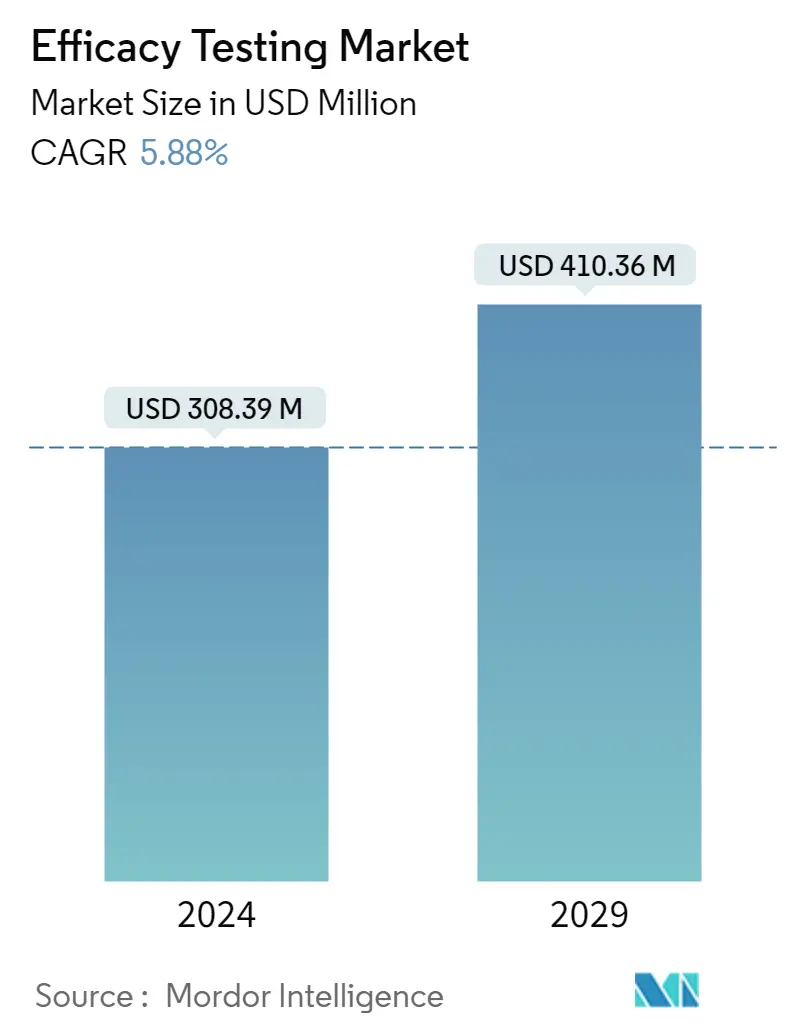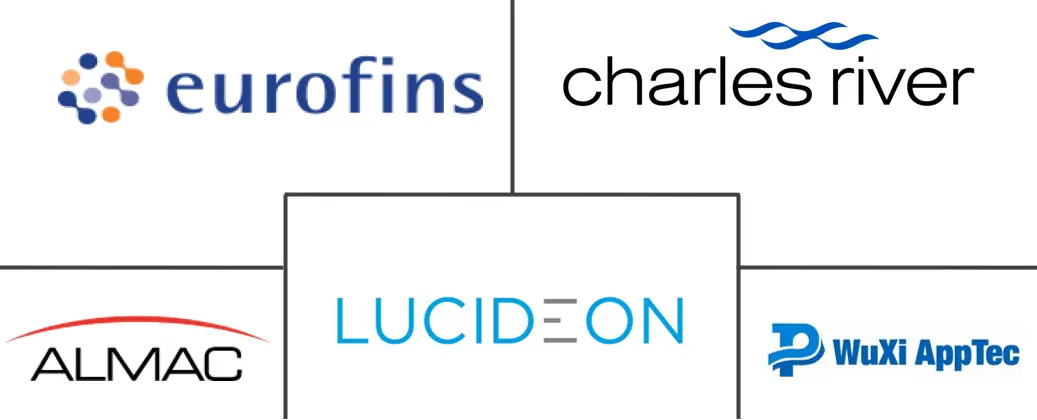Market Size of Efficacy Testing Industry

| Study Period | 2021 - 2029 |
| Market Size (2024) | USD 308.39 Million |
| Market Size (2029) | USD 410.36 Million |
| CAGR (2024 - 2029) | 5.88 % |
| Fastest Growing Market | Asia-Pacific |
| Largest Market | North America |
Major Players
*Disclaimer: Major Players sorted in no particular order |
Need a report that reflects how COVID-19 has impacted this market and its growth?
Efficacy Testing Market Analysis
The Efficacy Testing Market size is estimated at USD 308.39 million in 2024, and is expected to reach USD 410.36 million by 2029, growing at a CAGR of 5.88% during the forecast period (2024-2029).
The onset of the COVID-19 pandemic garnered efficacy testing for pharmaceutical products such as vaccines, drugs, and other medical products. A large customer base has fueled the sales of disinfecting products to prevent the spread of COVID-19 in their households. Thus, several laboratories and companies conducted efficacy testing of products. According to an October 2022 ARIC article, alcohol-based hand sanitizers (ABHS) were considered the gold standard for hand disinfection, but the required pH, viscosity, and hydrogen peroxide content of ABHS are a few parameters that are related to the products' functionality and acceptability by the users. Therefore, paying attention to and exercising control over the product's efficacy and safety is necessary. This increased the efficacy of testing during the pandemic. Additionally, in current times, the production of pharmaceutical products has increased, with an increase in research and development (R&D) of COVID-19 vaccines and drugs. This creates demand for efficacy testing of pharmaceutical products, ultimately fueling the market growth.
The studied market growth can largely be attributed to the factors such as an increase in outsourcing of research and development by the pharmaceutical sector and increasing adoption of the quality by design (QbD) approach.
Outsourcing assists organizations in the pharmaceutical sector to reduce both their operational and manufacturing costs and thereby minimize financial risk. Thus, pharmaceutical companies are increasingly outsourcing R&D activities to private contract research organizations (CROs) as a strategy for conducting research and development activities. For instance, in September 2022, Emyria Limited, a clinical-stage biotechnology company collaborated with PsychoGenics, a neuroscience preclinical drug discovery and contract research organization (CRO). Under this collaboration, Emyria uses PsychoGenic's drug discovery platform, SmartCube, which is a next-generation automated testing platform. Such instances are expected to increase the demand for efficacy testing products, and hence, it is anticipated to contribute to market growth over the forecast period.
Additionally, the QbD approach is adopted because it improves the functionality of efficacy testing by allowing for a systematic approach to drug development intended to enhance the quality by using analytical and risk management. Thus, the implementation of the QbD approach during efficacy testing enhances the development capability, speed, and formulation design. In addition, according to an article published in December 2021 in the AAPS open-access journal, the QbD strategy is known to have various benefits for the development of pharmaceutical products, including improved product and process expertise, reliable manufacturing processes, and regulatory flexibility regarding adjustments throughout the commercial phase with a significant focus on safety and efficacy testing. Thus, the demand for efficacy testing is increasing.
Moreover, according to the IFPMA's 2021 report, the annual R&D spending by the biopharmaceutical industry is 7.3 times higher than that of the aerospace and defense industries, 6.5 times more than the chemicals industry, and 1.5 times more than the software and computer services industry. The same source above also mentioned that the biopharmaceutical industry spent USD 196,000 million in 2021 and it is expected to increase to USD 213,000 million by 2024 over research and development activities. With increasing R&D in the biopharmaceutical industry for pharmaceutical product development, the adoption of the QbD approach is increasing among market players. This is expected to garner market growth. However, the high investment of time in testing procedures is likely to be an obstacle to growth.
